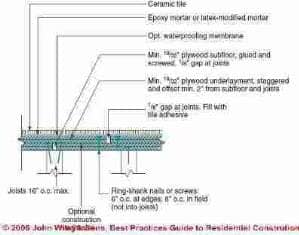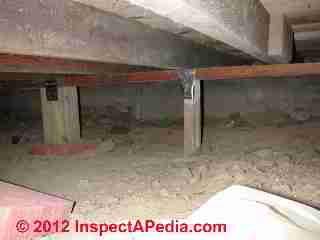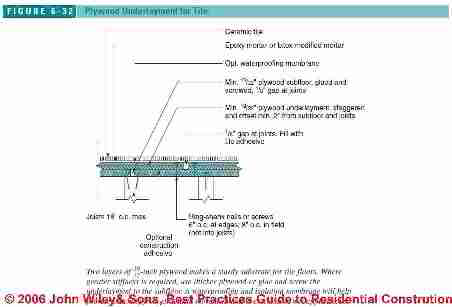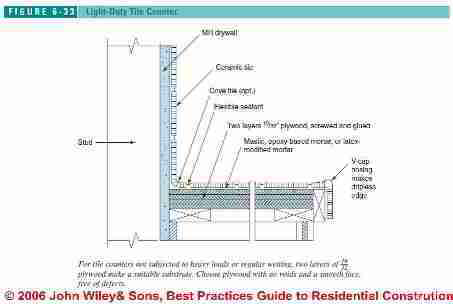 Floor-Framing & Subfloor Details for Ceramic or Stone Tile Flooring
Floor-Framing & Subfloor Details for Ceramic or Stone Tile Flooring
- POST a QUESTION or COMMENT about floor preparation for tile installation: framing, subflooring, underlayments, stiffness specifications or allowable deflection, and how to stiffen a floor that needs that improvement.
Floor framing for ceramic tile installations:
This article discusses floor framing and subfloor recommendations for use under ceramic tile, stone, granite, marble, and similar floors. We discuss the stiffness of floor framing needed to avoid cracks or loosening of ceramic tile, stone, slate, and similar flooring and we describe alternative methods of floor preparation for tiling. We address the floor framing and subflooring details for each of these tile types.
InspectAPedia tolerates no conflicts of interest. We have no relationship with advertisers, products, or services discussed at this website.
Recommended Floor Framing under Tile to Avoid Cracks
 This article series discusses current best design practices for kitchens and bathrooms, including layout, clearances, work space, and accessible kitchen and bathroom layout, clearances, turning space, grab bars, controls, etc.
This article series discusses current best design practices for kitchens and bathrooms, including layout, clearances, work space, and accessible kitchen and bathroom layout, clearances, turning space, grab bars, controls, etc.
We include advice on choosing and installing kitchen countertops, cabinets, and kitchen or bathroom flooring, sinks, and other plumbing fixtures and fixture controls such as faucets.
[Click to enlarge any image]
Tiles, stones, and grout joints crack easily from stresses imposed by movement. For a successful installation, the structure underneath must be very stiff.
On walls, 16-inch on-center framing with 2x4s or steel studs is usually adequate. Floors must be level and subject to minimal deflection under uniform or point loads.
Our photo (above left) illustrates an exploration and repairs we made in the crawl area under a bathroom before installing ceramic tiles on the floor above.
Floor Deflection Problems in Tile Floors Lacking Stiffness
An insufficiently stiff floor will crack ceramic or stone tiles. The Tile Council of America (TCA) specifies a maximum deflection for floors of L/360 under a 300-pound concentrated load.
While building codes limit deflection in living spaces to L/360 under uniform loads, code-compliant floors may still have too much flexing between joists under point loads.
Many natural stone tiles require stiffer conditions, ranging from L/480 to as stiff as L/720.
See details at FRAMING BLOCKING & BRACING
Subflooring Requirements for Tile Floors
To meet TCA stiffness requirements, floor framing should be no more than 16 inches on-center with minimum 19/32 -inch plywood subflooring. Upgrading to 23/32- inch plywood will stiffen the subfloor by almost 80% and provide a more solid feeling floor. T
he subflooring should be level to 1/8 inch in 10 feet. (TCA specs now permit 1/4 inch in 10 feet, but this can be problematic for the large tiles popular today.)
To avoid tile cracks caused by tight-fitting plywood joints, it is best to use square-edged subflooring under tile and leave an 1/8-inch gap between sheets (unless the setting material specifications require tight joints). Lay the plywood with its long dimension across the joists and use solid blocking at all open joints.
Two-Layer Subflooring System for Ceramic Tile Floors
To meet the stiffness requirements for natural stone floors may require two layers of subflooring screwed and glued together, with the upper layer serving as the underlayment.
Two layers of 19/32 inch plywood glued and screwed together on 6-inch centers is several times stiffer than a single layer (and over four times as stiff as a single layer of 23/32-inch plywood). Offset the upper layer so the joints do not line up with the joints in the lower layer or the joists.
Also, screws in the upper layer, which serves as underlayment for the tile, should penetrate the subfloor only and not the joists. Use underlayment- grade plywood or plywood rated C-C Plugged or Plugged Crossbands, with a smooth face and no voids.
Floor Substrates for Ceramic Tile: Concrete, Cement Backerboard, Plywood, Drywall, Plaster
Ceramic tile can be installed over clean and sound concrete, plywood, cement backerboard, drywall, or plaster. Most substrates can be used with either organic mastic or thinset mortar, but the installer should always check the adhesive label for compatibility with the substrate.
Plywood Underlayment Specifications for Tile for Floors or Countertops
Because of its stiffness and durability, exterior plywood makes an excellent substrate for tile in relatively dry applications.
- Plywood type.
The plywood should be free of internal voids such as underlayment grade, CC-Plugged, or Plugged Crossbands , and if tiling directly to plywood, it should have a sanded face free of voids, surface resin, or other surface defects.
While TCA specs allow 15/32-inch plywood underlayment over a 19/32 inch subfloor in residential work, upgrading to 19/32 inch underlayment is recommended for a trouble-free floor (Figure 6-32).
[Click any image or table to see an enlarged version with additional detail, commentary & source citation.]

- Plywood installation.
Leave a 1/8 -inch gap between sheets and make sure the edges of adjacent plywood sheets are no more than 1/32 inch out of plane. Overall, the surface should be level to 1/8 inch over 10 feet (1/4 inch is allowed by the tile industry but is not suitable for large tiles). Fasten with ring-shank nails or screws at 6 inches on-center. - Glue and screw.
Where greater stiffness is required in a floor, it is worth the effort to also glue the underlayment to the subfloor and upgrade from nails to screws. - Isolation membrane.
On large spans or where significant movement is expected in the floor due to wide moisture or temperature swings, a crack-isolation membrane is recommended as a precaution against cracking.
Membranes, if sealed at seams, can also protect the plywood from moisture that seeps through the tile system. This is required in wet applications and recommended in applications subject to occasional wetting, such as bathroom floors. - Countertops.
Plywood also works well as a tile substrate on walls and countertops not subject to regular wetting (Figure 6-33). In applications subject to high humidity or regular wetting, cement backerboard or glass-mat gypsum are better choices.

[Click any image or table to see an enlarged version with additional detail, commentary & source citation.]
Ceramic Tile-Setting Material Manufacturer List
Bonsal American www.bonsal.com Setting compounds, grouts, preformed shower pans, curbs, and niches. Also, distributor of backerboards, isolation membranes, and other tile-setting products
Color Caulk, div. of Roanoke Companies Group www.colorcaulk.com Color-matched caulking
Custom Building Products www.custombuildingproducts.com Elastomeric and liquid-applied membranes, self-leveling underlayments, setting compounds, and grouts
Laticrete International www.laticrete.com Trowel-on membranes, self-leveling underlayments, setting compounds, grouts, and sealants
Noble Company www.noblecompany.com CPE sheet membranes, trowel-on membranes, clamping ring drains, and preformed slopes, niches, and curbs
Mapei www.mapei.com Trowel-on and sheet membranes, self-leveling underlayments, setting compounds, grouts, and color-matched sanded caulks
Ceramic Tile Backerboard Producers
Custom Building Products www.custombuildingproducts.com Wonderboard cement backerboard, Easyboard cement and polystyrene lightweight backerboard, and Rhinoboard fiber-cement backerboard
Georgia-Pacific Gypsum www.gp.com/build Denshield gypboard backer with glass-matt facing
James Hardie Building Products www.jameshardie.com Fiber-cement backerboard
National Gypsum www.nationalgypsum.com Permabase lightweight cement and polystyrene backerboard
Schluter Systems www.schluter.com Kerdi tile membrane goes directly over drywall or other substrates
T. Clear Corp./Fin Pan Inc. www.finpan.com Util-A-Crete lightweight concrete backerboard
U.S. Gypsum www.usg.com Durock cement backerboard
W. R. Bonsal www.bonsal.com Extruded polystyrene backerboard with fiberglassreinforced cement facing
- - Adapted with permission from Best Practices Guide to Residential Construction (Steve Bliss, J Wiley & Sons) .
Reader Comments, Questions & Answers About The Article Above
Below you will find questions and answers previously posted on this page at its page bottom reader comment box.
Reader Q&A - also see RECOMMENDED ARTICLES & FAQs
On 2015-05-18 - by (mod) - Hydro Ban, by Laticrete
Jeff
For other readers: Hydro Ban, by Laticrete, (laticrete.com) is " is a thin, load bearing waterproofing/crack isolation membrane that DOES NOT require the use of fabric in the field, coves or corners. HYDRO BAN is a single component self curing liquid rubber polymer that forms a flexible, seamless waterproofing membrane.
HYDRO BAN bonds directly to a wide variety of substrates." used to avoid having to install a membrane or fabric below the tile.
(The use of fabrics or membranes may tolerate flexing floors or gaps or cracks in subflooring that can be trouble for some flooring and tiling systems. This product suggests that it can tolerate taps up to 1/8".). (Pertinent standards ANSI A118.10 and A118.12) The company provides detailed installation instructions via the website we just cited.
The company warns: : Do not bond to particle board, flake board, oriented strand board (OSB), luan, yellow pine, pressure/chemically treated wood, Masonite® or hardwood. Refer to Technical Data Sheet 152 for full details on plywood floors.
Typically you would take any of several options to stiffen the floor: adding a beam, adding blocking between joists, adding layers of solid core subflooring; About applying HydroBan, indeed I would respect the manufacturer's suggstions: they know what is necessary for successful use of their product.
On 2015-05-15 by Jeff Rudisill
We're remoding the bathroom in our newly purchased, less than 2 year old manufactured home. Our intent is to provide an accessible bathroom for my wife, including a barrier-free shower. We've purchased a 60" linear drain to be the "barrier" between the shower and the rest of the bathroom, and sufficient 12" x 24" porcelain tile to cover the complete floor and the shower walls up to the ceiling.
The tiling pro is planning to start next week to install a cement mud-pan and float the shower walls in mud as the backing for the tiles. I've installed "purple" (moisture resistant) drywall on the shower wall studs in prep of the cement wall going in.
The floor joists are 2x6's on 16" centers; the bathroom sub floor up to the shower is one layer of 5/8" OSB glued and stapled to the joists; the floor under the shower has been stripped of the OSB and replaced with 2"x10" dry Doug Fir blocks on edge between the joists to provide a solid floor and reduce the height of the drain.
In preping to apply HydroBan on the sub floor in the bathroom section, I've read some stuff that now gives me "cold feet" about the entire job. First, I've read that HydroBan can't be applied on OSB, but I've also recently read that the floor joists on such a job should be a minimum of 2"x10" (the span is roughly 12 feet).
I'm concerned that the floor is not structurally sound enough to support the mud and tile weight, and would appreciate your thoughts, even though you're a "tile guy" and not a structural engineer. My backup plan is to coat the entire wall's and floors with an elastomeric acrylic such as Metacrylic and coat that surface with an epoxy compound made to improve wear-life on the surface.
On 2015-03-20 by Max
Thank you very much.
On 2015-03-16 - by (mod) -
By safe perhaps you mean will the floor crack - the answer is it depends ... on the floor framing and its rigidity, which may vary depending on the age of home and how it was built.
On 2015-03-11 by Max
Is it safe to install ceramic tiles on the second floor of a 3 story wooden frame building?
On 2015-01-05 - by (mod) -
Smart question and our mistake not to make this clear. In various construction and architectural or engineering specifications for structures the engineer or architect describes the amount of "bend" or "sag" that is permitted by a standard or in a structural member.
Because the amount of sagging that is acceptable may vary by the span or "length" or "distance" of the supporting member, the engineer or architect express sag or deflection or bending as a ration of L / nnn where L = "Length" measured in inches, and /nnn = a standard, also in inches.
So if we applied an L/360" standard to say a floor or floor joist in which the floor spans 12 feet we can calculate (as an example)
12 ft x 12 inches per foot = 144" of total span
Now 144" / 360" (L / 360") = 0.4" - telling us that 0.4" of sag below a straight horizontal line might be measured at the center of the span. Which in my OPINION sounds a bit saggy. But in fact it'd be barely noticeable to building occupants.
Why? Because while the total sag is most at the center of the span (usually), in fact the sag or bend is distributed over the entire span which is 144 inches across. That 0.4" is distributed (usually) at a rate from 0 - at the supporting walls to 0.4" at the center of the span. That means that from one side or one supporting wall the floor falls 0.4" over half of the total span - distributing that 0.4" on a slope over half the span or 72". 0.4" spread over 72" is not easily seen. If the sag were a straight line (it's not, it's an arc) the fall across the floor would be just .005 inches of sag per inch of run. Not so saggy after all. I'm more saggy than that. - DF
On 2015-01-04 by Dutch Schorr
What does "maximum deflection of L/360" mean?
On 2014-02-03 - by (mod) -
Bruce:
Certainly your floor is not framed to common dimensions (which space floor joists 16" O.C.) - I GUESS that perhaps there is some additional blocking or thick subflooring or there may be frequent support beams at right angles to the joists to prevent sagging and to avoid bouncy floors.
I agree completely that it would be risky to install slate (or ceramic tile) on a floor framed as you describe without further investigation. Have you taken a look inside the floor structure, perhaps from the ceiling below, to understand the dimensions and spans?
On 2014-02-01 by Bruce
I want to install 12 x 12 gauged slate on my second level floor. I have 1 1/4" thick (as measured on a tape measure)sub floor. The joists under the sub floor are 14" x 2 1/2" x 14' and are 32" on center. My house was built in 1971. It's hard to find accurate information with 32" on center floor joists. I'm concerned about deflection causing cracks in my grout, or worse my tile. It seems like a "beefy" structure to support my tile, but am really sure. Any thoughts. (I posted too soon previously, ignore similar but unfinished comment)
On 2014-02-01 by Anonymous
I want to install 12 x 12 gauged slate on my second level floor. I have 1 1/4" thick (as measured on a tape measure)sub floor. The joists under the sub floor are 14" x 2 1/2" x 14' and are 32" on center. My house was built in 1971. It's hard to find accurate information with 32" on center floor joists.
...
Continue reading at CERAMIC TILE FLOOR & WALL or select a topic from the closely-related articles below, or see the complete ARTICLE INDEX.
Or see these
Recommended Articles
- BATH & KITCHEN DESIGN GUIDE - home
- CERAMIC TILE FLOOR, WALL
- CEMENT BACKERBOARD INSTALLATION
- FLOOR FRAMING & SUBFLOOR for TILE
- FLOOR TILE SEALERS, CERAMIC, STONE
- TILED WALKING SURFACE SLIP HAZARDS
- CERAMIC TILE, ASBESTOS / LEAD?
- CERAMIC TILE BACKSPLASH INSTALLATION
- CERAMIC TILE DAMAGE REPAIR
- CERAMIC TILE GROUT INSTALLATION
- CERAMIC TILE FLOOR & WALL
- CERAMIC TILE SETTING COMPOUNDS
- CERAMIC WALL TILE INSTALLATION
- FLOOR DAMAGE DIAGNOSIS
- FLOOR DESIGNS: KITCHEN & BATH
- FLOOR FRAMING & SUBFLOOR for TILE
- FLOOR, RESILIENT VINYL or CORK
- FLOOR, STONE, GRANITE, MARBLE, AGGLOMERATE
- FLOOR TILE INSTALL on CONCRETE
- FRAMING BLOCKING & BRACING - stiffen the floor structure
Suggested citation for this web page
FLOOR FRAMING & SUBFLOOR for TILE at InspectApedia.com - online encyclopedia of building & environmental inspection, testing, diagnosis, repair, & problem prevention advice.
Or see this
INDEX to RELATED ARTICLES: ARTICLE INDEX to BATH & KITCHEN
Or use the SEARCH BOX found below to Ask a Question or Search InspectApedia
Ask a Question or Search InspectApedia
Try the search box just below, or if you prefer, post a question or comment in the Comments box below and we will respond promptly.
Search the InspectApedia website
Note: appearance of your Comment below may be delayed: if your comment contains an image, photograph, web link, or text that looks to the software as if it might be a web link, your posting will appear after it has been approved by a moderator. Apologies for the delay.
Only one image can be added per comment but you can post as many comments, and therefore images, as you like.
You will not receive a notification when a response to your question has been posted.
Please bookmark this page to make it easy for you to check back for our response.
Our Comment Box is provided by Countable Web Productions countable.ca
Citations & References
In addition to any citations in the article above, a full list is available on request.
- In addition to citations & references found in this article, see the research citations given at the end of the related articles found at our suggested
CONTINUE READING or RECOMMENDED ARTICLES.
- Carson, Dunlop & Associates Ltd., 120 Carlton Street Suite 407, Toronto ON M5A 4K2. Tel: (416) 964-9415 1-800-268-7070 Email: info@carsondunlop.com. Alan Carson is a past president of ASHI, the American Society of Home Inspectors.
Thanks to Alan Carson and Bob Dunlop, for permission for InspectAPedia to use text excerpts from The HOME REFERENCE BOOK - the Encyclopedia of Homes and to use illustrations from The ILLUSTRATED HOME .
Carson Dunlop Associates provides extensive home inspection education and report writing material. In gratitude we provide links to tsome Carson Dunlop Associates products and services.

